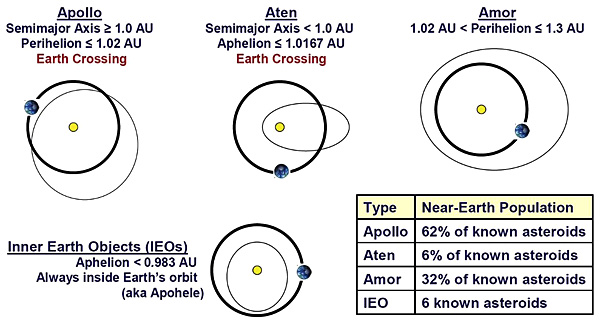Near-Earth Asteroid

Asteroids with orbits that bring them within 1.3 AUThe astronomical unit for length is described as the "mean" distance (average of aphelion and perihelion distances) between the Earth and the Sun. Though most references state the value for 1 AU to be approximately 150 million kilometers, the currently accepted precise value for the AU is 149,597,870.66 km. The Click on Term to Read More (195 million km) of the SunOur parent star. The structure of Sun's interior is the result of the hydrostatic equilibrium between gravity and the pressure of the gas. The interior consists of three shells: the core, radiative region, and convective region. Image source: http://eclipse99.nasa.gov/pages/SunActiv.html. The core is the hot, dense central region in which the. NEAs are a dynamically young population whose orbits evolve on 100-million-year time scales because of collisions and gravitational interactions with the Sun and the terrestrial planetsRocky planets: Mercury, Venus, Earth, and Mars. These planets have physical characteristics, chemical composition and internal structure similar to the Earth. The terrestrial planets have 0.4% of the total mass of all the planets in the Solar System. Some large satellites of planets are also similar to the characteristics of. These asteroids are probably ejected from the main beltBelt located between 2.12 and 3.3 AU from the Sun and located between the orbits of Mars and Jupiter containing the vast majority of asteroids. The asteroid belt is also termed the main asteroid belt or main belt to distinguish it from other asteroid populations in the Solar System such Click on Term to Read More by a combination of asteroid collisions and the gravitational influence of Jupiter. Some NEAs may be the nuclei of dead, short-period comets. Approximately 250 NEAs have been found to date, probably only a few percent of their total population. The largest presently known is 1036 Ganymed, with a diameter of ~25.5 miles (41 kilometers). The NEA population appears to represent most or all asteroid types found in the main belt. NEAs are grouped into three categories, named for famous members of each: 1221 Amor, 1862 Apollo, and 2062 Aten. The Amors cross Mars’ orbitThe elliptical path of one body around another, typically the path of a small body around a much larger body. However, depending on the mass distribution of the objects, they may rotate around an empty spot in space • The Moon orbits around the Earth. • The Earth orbits around Click on Term to Read More but do not quite reach the orbit of Earth. The Apollos cross Earth’s orbit and have periods >1 year. The Atens cross Earth’s orbit and have periods <1 year. With expected lifetimes of around 10 million years, the ultimate fate of NEAs may be gravitational ejection from the Solar SystemThe Sun and set of objects orbiting around it including planets and their moons and rings, asteroids, comets, and meteoroids. or collision with one of the terrestrial planets.
Some or all content above used with permission from J. H. Wittke.






